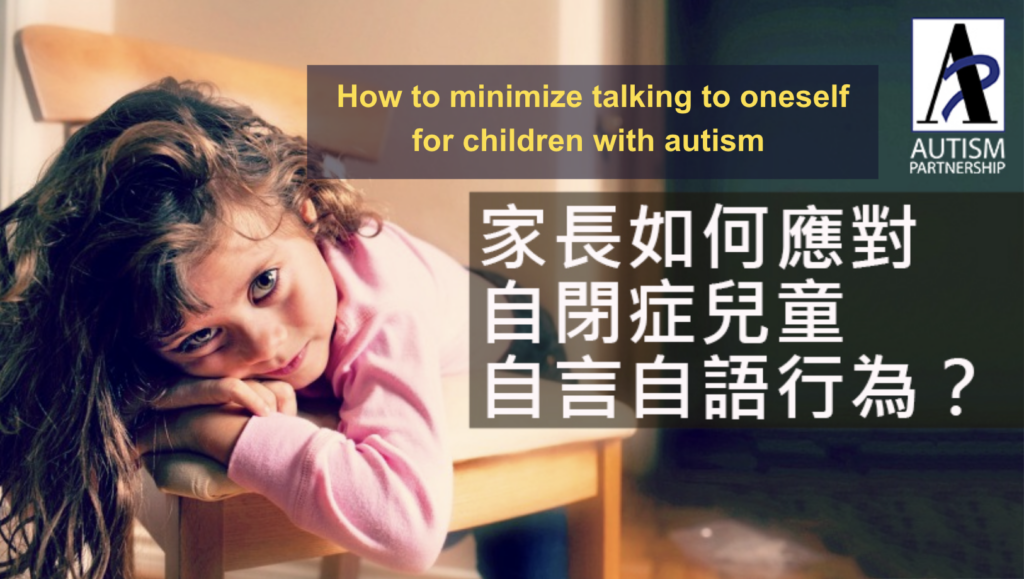
“Beep, beep, beep. Please be careful with the door…” This is a challenge faced by the parents of one of my students every day. Her son loves the MTR, whether he is playing at home, eating, bathing, walking, at school, or on the bus. The above broadcast is repeated on every occasion, which sometimes makes people think it is cute, but sometimes it makes the mother feel embarrassed.
Talking to oneself is a very common trait in children with autism. Some of them only have confusing pronunciation; some have specific content, but they are often repeated in inappropriate situations. In most cases, they seem to get happier and happier and even become so focused that they ignore the things around them, causing them to miss many opportunities to learn and establish good social relationships. When children focus on talking to themselves, most parents will use both soft and hard tactics.
On the one hand, they will stop the child sternly, and on the other hand, they will patiently explain, such as “This will affect other people,” “It will make people dislike it,” “It needs to be there.” Parents hope that children can understand the truth, focus on learning, and avoid committing the same crime again; sometimes they will take out the children’s favourite toys, candies, etc. to try to distract their attention. Most children will stop when adults tell them to stop, but many times they quickly return to their old ways, or even repeat the same words a few seconds later, which often makes people feel very discouraged.


At home or at school, children should be taught and encouraged to take the initiative to express their negative emotions to their families and teachers in words, such as “I’m not happy today!”, “I’m so angry!”, etc., so that others can help in time. It is more suitable for children to soothe their emotions.
Parents can observe more and actively communicate with teachers to understand what kind of difficulties children are particularly likely to be emotional about, so as to strengthen tolerance practice at home.

To sum up, in order to long-term and effectively improve the self-talk of autistic children, we cannot just rely on immediate reminders and stops from people around us, but more importantly, we must strengthen the children’s ability to independently handle their own free time and manage their emotions. Encourage them to develop more diverse interests and activities.
This is a learning process. Although it may take a long time, as long as you persist, you can continue to reduce your self-talk. I hope the information can help everyone.
Autism Partnership (AP) is one of the most established Applied Behavior Analysis (ABA) service providers for Autism Spectrum Disorders (ASD) in the world. Formed in 1994 in the United States, AP is run by professional clinicians and specializes in providing one-on-one therapy, group interventions and overseas consultation for children with ASD and their families.

Every little life is a special present for a family. From the time a baby is born, parents journey through lots of highs and lows, wishing for their child to grow up with a big smile, make great friends, find their own way in a job they love, and create a happy family. However, for […]

Parenthood is a journey filled with unexpected twists and turns, challenges, and moments of profound joy. For Adam’s father, the discovery that his son, Adam, was on the autism spectrum marked the beginning of a unique chapter in their lives. This is the story of a father’s realization, acceptance, and the unconditional love and strength […]

Autism Spectrum disorder can be diagnosed as early as 18 months. Research shows strong evidence on how effective Applied Behavior Analysis (ABA) can help children with Autism. It helps to deal with children’s challenging behaviors such as inattention, aggression, self-stimulation, etc. Howard, et al (2005) conducted a study to compare the effectiveness of 3 treatment […]
Please share to let more people learn about ASD and ABA therapy:
AP holds the belief that with quality Autism Partnership Method (APM) treatment, individuals with autism should reach their fullest potential and achieve the greatest degree of independence and highest quality of life possible.

Sign up now to get ABA and Autism related news delivered to your inbox. Enter your email to get started
Hong Kong Center
Kowloon Center

All information received will always remain confidential. We will contact you as soon as we review your message. Thanks